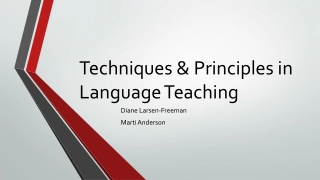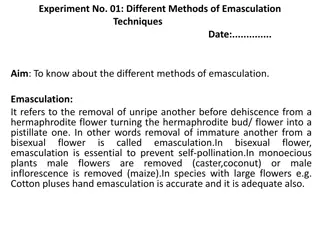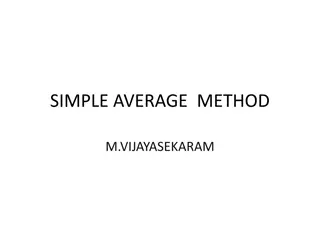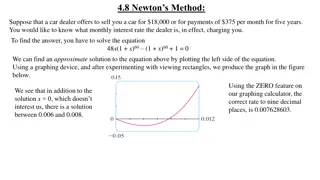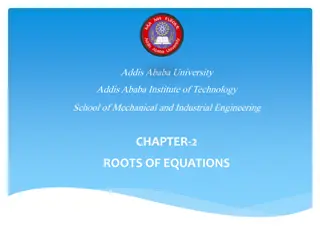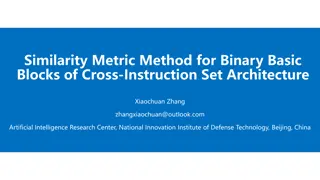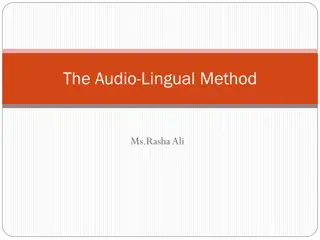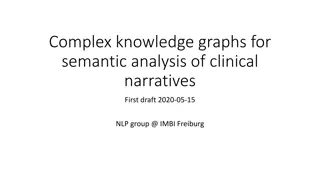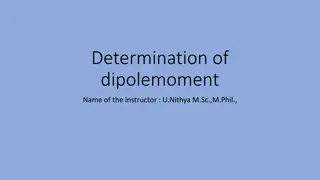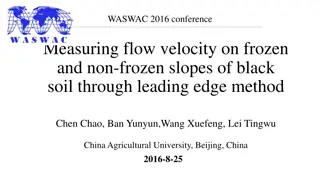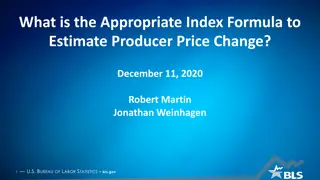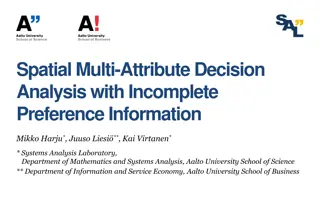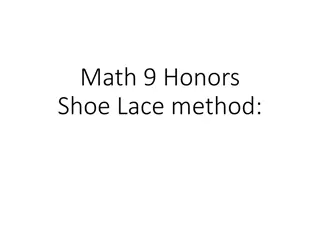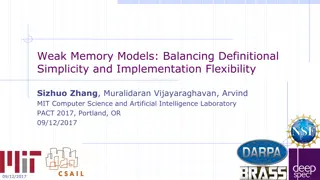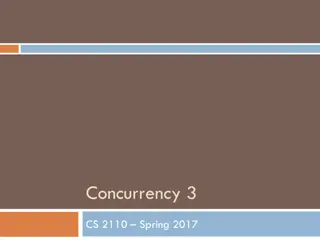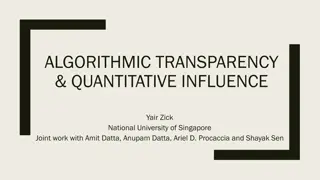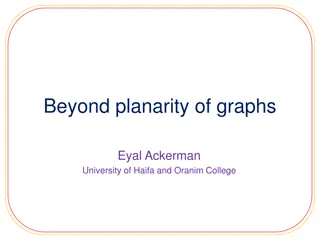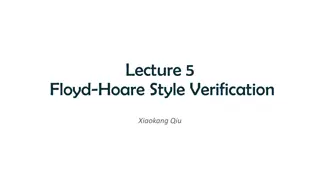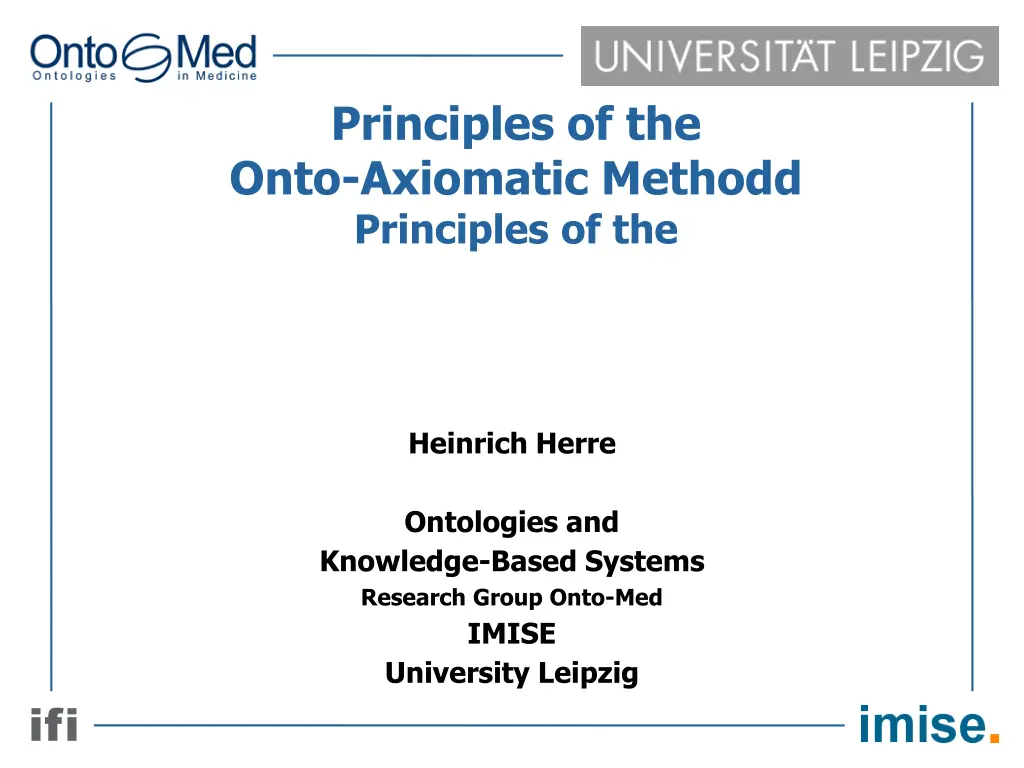
Formal Ontology Principles and Foundations
Explore the principles and foundations of formal ontology as a structured approach to describing the nature of the world at various levels of granularity and abstraction. Delve into the interdisciplinary relations, development of top-level ontologies, and the applications in computer-based systems. Discover the key distinctions between categories, sets, and individuals within ontological frameworks.
Download Presentation

Please find below an Image/Link to download the presentation.
The content on the website is provided AS IS for your information and personal use only. It may not be sold, licensed, or shared on other websites without obtaining consent from the author. If you encounter any issues during the download, it is possible that the publisher has removed the file from their server.
You are allowed to download the files provided on this website for personal or commercial use, subject to the condition that they are used lawfully. All files are the property of their respective owners.
The content on the website is provided AS IS for your information and personal use only. It may not be sold, licensed, or shared on other websites without obtaining consent from the author.
E N D
Presentation Transcript
Principles of the Onto-Axiomatic Methodd Principles of the Heinrich Herre Ontologies and Knowledge-Based Systems Research Group Onto-Med IMISE University Leipzig ifi
Ontology as Science 1 Science/discipline wich is concerned with a systematic development of axiomatic theories describing forms and modes of being of the world at different levels of granularity and abstraction. ifi
Ontology as Science 2 is concerned with: a) Principles for developing category systems b) Development of top level ontologies c) Usage of top level ontologies as a framework i) to specify a domain ii) to analyse the entities of a domain iii) construction of categorizations of a domain and of formal axiomatizations ifi
Ontology as Science 3 Interdisciplinary Relations Artif. Intelligence Computer Science Philosophy Logic Linguistics Formal Ontology ifi
Ontology as Science (4) Associations, Societies IAOA (International Association of Ontology and its Applications, founded 2009) Journals: Applied Ontology, Axiomathes Conferences: FOIS (Formal Ontology for Information Systems) 2. OBML-Workshop (Ontologies in Biomedicine and Life Sciences) (9.-10.09.2010,Mannheim) OBML-Fachgruppe, founded 2010 http:// ifi
Onto-Med Foundations of Formal Ontology Conceptual Tools for Development and Integration of Ontologies Domain-specific Ontologies, Core Ontologies Computer-based Applications Contact heinrich.herre@imise.uni-leipzig.de http://www.onto-med.de <<Thema / Veranstaltung>> <<Datum>> <<Vortragender>>
Ontologies 1 Basic Distinction: Category, Set, Individual Category A category is an abstract entity, it is presented by a linguistic expression F describing a system of conditions which can be predicated of entities (pred(C,e)) satisfied by entities. (sat(e,C)) instantiated by entities (e::C) <<Thema / Veranstaltung>> <<Datum>> <<Vortragender>>
Ontologies 2 Individual - cannot be instantiated - is uniquely determined - can be concrete or abstract: concrete (is in time-space) := this tree, this lion abstract (number pi) Old problem in philosophy Franciso Suarez: ber die Individualit t und das Individuationsprinzip Aristotle: Metaphysics <<Thema / Veranstaltung>> <<Datum>> <<Vortragender>>
Ontologies 3 Set: - is abstract (independent of time-space) - has elements (cannot be instantiated!) - can be reduced to singletons (i.e. object A {A}) <<Thema / Veranstaltung>> <<Datum>> <<Vortragender>>
Ontologies 4 Ontologies as knowledge bases An ontology is an axiomatization of a conceptualization represented in a formal language (T. Gruber) Formal systems for representation: logic languages (FOL, DL, CL, OWL) graph-based systems (semantic nets, conceptual graphs, OBO-format) <<Thema / Veranstaltung>> <<Datum>> <<Vortragender>>
Ontologies 5 Levels of generality of ontologies Top-Level Ontologies (TLO) Core Domain Ontologies (CDO) Domain ontologies (DO) <<Thema / Veranstaltung>> <<Datum>> <<Vortragender>>
Ontologies 6 Beispiele von Top-Level Ontologien DOLCE (Trento, N. Guarino) GFO (General Formal Ontology, Leipzig) BFO (Basic Formal Ontology, B. Smith) SUMO (Standard Upper Merged Ontology) <<Thema / Veranstaltung>> <<Datum>> <<Vortragender>>
GFO 1 GFO (General Formal Ontology) is a top level ontology being developed by the research group Onto-Med. Some implemented unique features: Integration of objects and processes Multiple category approach Integrative realism Levels of reality Categories of higher order http://www.onto.med.de <<Thema / Veranstaltung>> <<Datum>> <<Vortragender>>
GFO 2 Classification of Categories Category Transcendental Category Universal ? Concept Symbol Multiple category approach: J. E. Gracia: Metaphysics and its Tasks: The Search for the Categorial Foundation of Knowledge. SUNY Series in Philosophy. Albany , 1999 <<Thema / Veranstaltung>> <<Datum>> <<Vortragender>>
GFO 3 Meta-Architecture Abstract top level Set / Item Abstract Core Level Basic Level <<Thema / Veranstaltung>> <<Datum>> <<Vortragender>>
GFO 4 (Abstract Core Level) Item Category Individual Space Time Symbol Structure Concrete abstract Concept Universal <<Thema / Veranstaltung>> <<Datum>> <<Vortragender>>
GFO 5 (Selected Categories ) concrete individual complex individual space-time entity role function relator quality spatial entity time entity presential perpetuant processual structure process change space region spatial boundary time region time material structure configur- ation boundary situation situoid material boundary material object topoid chronoid <<Thema / Veranstaltung>> <<Datum>> <<Vortragender>>
Ontological Modelling 1 Domain D (Part of the World) Domain Specification Conceptualization Axiomatization Implementation <<Thema / Veranstaltung>> <<Datum>> <<Vortragender>>
Ontological Modelling 2 Domain Specification A domain specification for D is determined by: a set Obj(D) of objects a set V of views a set CP of classification principles Spec(D) = (Obj(D), V, CP) <<Thema / Veranstaltung>> <<Datum>> <<Vortragender>>
Ontological Modelling 3 Conceptualization A conceptualization for a domain specification DS = (Obj(D), V, CP) is determined by: Obj(D) a set of objects Cat(D) a set of categories associated to D (based on the classification principles and views in D) a set Rel(D) of relations on Ind and/or Cat(D) Denote Concept(D) = (Ind(D), Cat(D), Rel(D)) to be a conceptualization for D.
Ontological Modelling 4 Graduated conceptualizations Let Concept(D) be a conceptualization of the domain D, and Cat(D) a set of categories associated with D. The categories Cat(D) of a conceptualization can be classified into principal categories (PC) elementary categories (EC) aspectual categories (AC) PC EC AC (graduated conceptualization)
Ontological Modelling 6 Conceptualization: Classical Biology Principal categories (first order): organism (autopoietic systems) principal categories (second order): species Elementary categories: Kingdom, Order, Family, Genus, Species. <<Thema / Veranstaltung>> <<Datum>> <<Vortragender>>
Ontological Modelling 7 Basic Problems related to conceptualizations. 1) Problem of uncompleteness: the conceptualization lacks important notions, the extension does not cover the domain 2) Problem of irrelevance: the chosen concepts and relations do not allow to formalize relevant knowledge about the domain
Ontological Modelling 8 Axiomatization OntoKnow(D) = (Ax, Concepts(D), Rel(D)) Axioms are logical inter-relations between the concepts and relations. Elementary axioms (elementary sentences) have the from R(C1, C2), R a relation between concepts. Example: - ape is-a mammal - hand is-part-of human
Ontological Modelling 9 Implementation Translation of a representation of an axiomatization into an executable language or into UML (the notion of implementation varies) Ax(D) should be independent of any implementation, Ax(D) formalized in some logic standard language (FOL, CL) <<Thema / Veranstaltung>> <<Datum>> <<Vortragender>>
Ontological Modelling 10 A knowledge system OntoKnow(D) as a result of the development steps: Domain Domain Specification Conceptualization Axiomatization = OntoKnow(D) and using a top level ontology TLO is called ontologically founded in TLO. TLO provides a semantics for OntoKnowl(D). <<Thema / Veranstaltung>> <<Datum>> <<Vortragender>>
Ontological Foundation (1) Given an ontology Ont = (Tm, Conc, Rel, Def, Ax ). Forms of foundation: - ontological embedding, - ontological reduction
Ontological Foundation (2) 1) Ontological embedding Ont in Ont(1) Ont(1) = (Tm(1), Conc(1), Rel(1), Def(1), Ax(1)). Find a function f from Tm into Tm(1) such that for t in T and c, den(t,c) holds c is-a f(c). Ontological Embedding is the simplest form of ontological foundation. Example: house Ont, material object Ont(1), house is-a f(house) = material object
Ontological Foundation (3) Ont Ont(1) Material Object House is-a
Ontological Foundation (4) Let Ont(D) be a domain-specific ontology, and TLO a top-level-ontology. TLO-Ont(D) denotes the ontological embedding of Ont(D) into TLO. TLO-Ont(D) is a extension of Ont(D) since a number of top-level-categories of TLO are added to the categories of Ont(D). We use in the following the term GFO-Ont(D) if Ont(D) is embedded into GFO.
Ontological Foundation (5) 2) Ontological reduction Ont(1) and Ont(2) be given. Ont(i) = (Tm(i), Conc(i), Rel(i), Def(i), Ax(i)), i =1,2. Ont(1) is ontologically reduced to Ont(2) by a function f iff f translates Conc(1), Rel(1), Def(1), Ax(1) into the language of Ont(2). <<Thema / Veranstaltung>> <<Datum>> <<Vortragender>>
Ontological Foundation (6) Assumption 1 A formal (logic-based) ontology T = Ax(C1,...,Cm, R1,..,Rn) is represented in a formal language L as a set of expressions (axioms) of L (Target Language) C1,...,Cm denote categories R1,..,Rn denote relations between categories (or between instances of categories or between instances and categories).
Ontological Foundation(7) Assumption 2 Let E be a set of expressions of a language L (L is not necessarily formal, f.e. terminological systems with natural language definitions). Basic Task: find a function f from E into L such that for every G from E holds f(G) is a formal expression ( a sentence ) of the language L G and f(G) are semantically equivalent in T.
Ontological Foundation(8) The following steps must be distinguished: 1.Construction of a set PC(E) of primitive concepts extracted from the set E. (Primitive Base Problem) 2.Construction of an extension T1 of T by adding new categories, relations and axioms. (Extension and Axiomatizability Problem)
Ontological Modeling Issues 1: Functions Recently, the notion of function is defined as follows: it is a continuant which typically has a bearer B which is a continuant and a realization R which is a process. But what about ? Function: to pump blood Bearer: heart Realization: the process of blood being pumped artificial hearts function is the same but the bearer differs? passive functions realizable not by a processes but by presentials e.g. function of a chameleon s covering: to camouflage?
Ontological Modeling Issues 2: Processes and Objects Ambiguity of understanding of the concept of cell C: C is a process running from t1 to t2 having a dynamics (geneological tree) C is an object at time-point t characterized by shape, size, position, C is a persisting entity which is identical through time and may die, divide, move, Cell(C2)
End Thank you!

